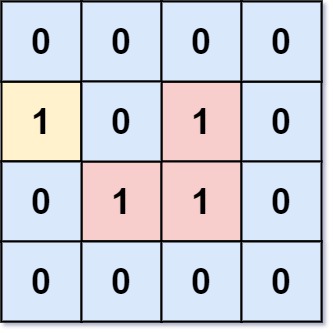You are given an m x n binary matrix grid, where 0 represents a sea cell and 1 represents a land cell.
A move consists of walking from one land cell to another adjacent (4-directionally) land cell or walking off the boundary of the grid.
Return the number of land cells in grid for which we cannot walk off the boundary of the grid in any number of moves.
Example

Input: grid = [[0,0,0,0],[1,0,1,0],[0,1,1,0],[0,0,0,0]]
Output: 3
Explanation: There are three 1s that are enclosed by 0s, and one 1 that is not enclosed because its on the boundary.
Solution
/**
* @param {number[][]} grid
* @return {number}
*/
var numEnclaves = function (grid) {
//Assign count, rows, and cols
let m = grid.length;
let n = grid[0].length;
let count = 0;
//Function to check if island is closed
function dfs(x, y, grid) {
if (
x < 0 ||
x >= grid.length ||
y < 0 ||
y >= grid[0].length ||
grid[x][y] == 0
) {
return;
}
//Mark as visited
grid[x][y] = 0;
dfs(x + 1, y, grid);
dfs(x - 1, y, grid);
dfs(x, y + 1, grid);
dfs(x, y - 1, grid);
}
// Exclude connected group of 0s on the corners because they are not closed island.
for (let i = 0; i < m; i++) {
for (let j = 0; j < n; j++) {
//If 0 and on the edge, run dfs
if (grid[i][j] == 1 && (i == 0 || i == m - 1 || j == 0 || j == n - 1)) {
dfs(i, j, grid);
}
}
}
//Count remaining 1s
for (let i = 0; i < m; i++) {
for (let j = 0; j < n; j++) {
if (grid[i][j] == 1) {
count++;
}
}
}
return count;
};